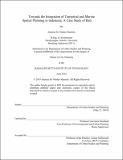| dc.contributor.advisor | Lawrence Susskind. | en_US |
| dc.contributor.author | Mamola, Jeremia Sir Nindyo. | en_US |
| dc.contributor.other | Massachusetts Institute of Technology. Department of Urban Studies and Planning. | en_US |
| dc.date.accessioned | 2020-02-28T20:53:30Z | |
| dc.date.available | 2020-02-28T20:53:30Z | |
| dc.date.copyright | 2019 | en_US |
| dc.date.issued | 2019 | en_US |
| dc.identifier.uri | https://hdl.handle.net/1721.1/123976 | |
| dc.description | This electronic version was submitted by the student author. The certified thesis is available in the Institute Archives and Special Collections. | en_US |
| dc.description | Thesis: M.C.P., Massachusetts Institute of Technology, Department of Urban Studies and Planning, 2019 | en_US |
| dc.description | Cataloged from student-submitted PDF version of thesis. | en_US |
| dc.description | Includes bibliographical references (pages 134-144). | en_US |
| dc.description.abstract | Indonesia is the largest archipelagic state in the world. It holds very important marine resources and some of the most biodiverse marine ecosystems. Marine spatial planning, a tool that can be used to control development and maintain ecosystem services, is vital to the future of the marine environment in Indonesia. Since 2007, the national government has required each province to create a Marine Spatial Plan (MSP). These are supposed to mesh with the already long-standing Terrestrial Spatial Plans (TSP). Together, these plans are meant to provide the underpinning for a range of government programs as well as permitting and licensing systems. The marine and terrestrial spatial plans must be synchronized to avoid conflicts and achieve the anticipated ecological and socio-economic objectives. In Bali, one of the provinces that is currently working on a new MSP and a revised TSP, the MSP appears to be driven almost entirely by the existing TSP. This could lead to future conflicts and a failure to achieve important environmental and social objectives because of lack of cross-realm consideration in the two plans. In this thesis, I look at the current barriers to the integration of MSP and TSP in Bali and Indonesia. In my view, it is necessary for the government, in particular, the ministries that are responsible for spatial planning, to require both types of plans to be prepared at the same time. To do so, they need new procedures to ensure harmonization of land-sea considerations and improve local government capacities and commitment. In the long term, it may be necessary for the government to amend the existing legislation (Laws Number 26 and 27 Year 2007) to accommodate a more integrative approach to spatial planning of the land and the sea. | en_US |
| dc.description.statementofresponsibility | by Jeremia Sir Nindyo Mamola. | en_US |
| dc.format.extent | 144 pages | en_US |
| dc.language.iso | eng | en_US |
| dc.publisher | Massachusetts Institute of Technology | en_US |
| dc.rights | MIT theses are protected by copyright. They may be viewed, downloaded, or printed from this source but further reproduction or distribution in any format is prohibited without written permission. | en_US |
| dc.rights.uri | http://dspace.mit.edu/handle/1721.1/7582 | en_US |
| dc.subject | Urban Studies and Planning. | en_US |
| dc.title | Towards the integration of terrestrial and marine spatial planning in Indonesia : a case study of Bali | en_US |
| dc.type | Thesis | en_US |
| dc.description.degree | M.C.P. | en_US |
| dc.contributor.department | Massachusetts Institute of Technology. Department of Urban Studies and Planning | en_US |
| dc.identifier.oclc | 1140509492 | en_US |
| dc.description.collection | M.C.P. Massachusetts Institute of Technology, Department of Urban Studies and Planning | en_US |
| dspace.imported | 2020-02-28T20:53:29Z | en_US |
| mit.thesis.degree | Master | en_US |
| mit.thesis.department | UrbStud | en_US |
